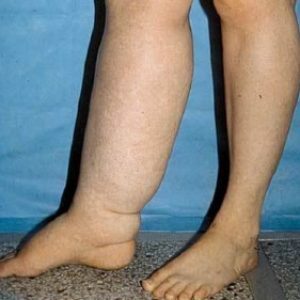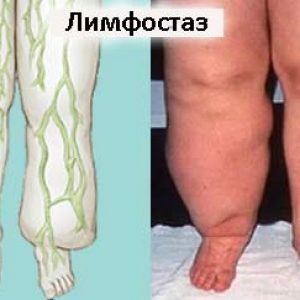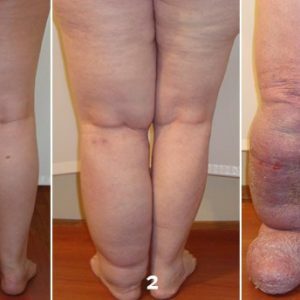Lymphedema, or elephantism: symptoms and treatment

Lymphedema is a pathology caused by malfunctions in the lymphatic system.Diagnosed with a violation of outflow of the lymphatic fluid and is characterized by the appearance of edema of the soft tissues of the extremities, less often the scrotum.Most often develops due to congenital pathologies, although medicine also knows cases of the appearance of lymphedema as a result of serious injuries, labor.
Table of contents: General information Causes Symptoms of lymphedema Types and stages Diagnosis Treatment of lymphedema Prognosis and possible complications PreventionGeneral information
Lymphedema, or elephantiasis, elephantiasis, elephantiasis - all these terms describe the state in whichThe region of the extremities, most often the lower ones, the swelling grows, thereby jeopardizing the motor activity of the person.When the disease occurs, chronic obstruction of the lymph drainage pathway, which results in the accumulation of toxins.Because of this, bacteria, harmful substances, elements of leukocytes are not withdrawn from the body, but continue to be stored in soft tissues.
Please note! According to statistics, a difficult outflow of lymph is diagnosed in every tenth person on the planet.At the same time, 10 million people have lymphedema, caused by the ingestion of a chronic infection.
At the risk, first of all, people suffering from peripheral vascular diseases.Up to 7% of them are already ill with lymphedema, and this figure is steadily growing. The disease is not treatable.The success of the latter is determined not only by the correctness of the selected therapy, but also by the way of life of the patient.
Causes of
 Most commonly, the disease manifests itself as a result of disturbances in the lymphatic system.They disrupt the normal flow of the lymph fluid and, as a consequence, cause the development of edema .This fluid contains fats and proteins, which normally should be cleared in the lymph nodes, and then pass further along the lymphatic ways.However, when a pathology occurs, the lymph flow is delayed.
Most commonly, the disease manifests itself as a result of disturbances in the lymphatic system.They disrupt the normal flow of the lymph fluid and, as a consequence, cause the development of edema .This fluid contains fats and proteins, which normally should be cleared in the lymph nodes, and then pass further along the lymphatic ways.However, when a pathology occurs, the lymph flow is delayed.
If the disorders that provoke a difficult outflow are congenital, for example, a person is diagnosed with underdevelopment, valve incompetence or aplasia of peripheral lymphatic vessels, primary lymphedema is detected.In this case, the disease appears already in childhood or in adolescence, mainly in girls.In boys, the disease is diagnosed 4 times less often.In this case, all can swell both the lower and upper limbs.
Also in medical practice, is allocated secondary, or acquired lymphedema .It is characterized by a change in lymphatic drainage due to acquired blockage in the lymph nodes or the destruction of lymphatic canals.
This happens for a number of reasons, including:
Excess weight and cellulite. Varicose veins, thrombophlebitis, phlebitis and other diseases of the venous system.
Varicose veins, thrombophlebitis, phlebitis and other diseases of the venous system.Along with the above-described reasons to provoke the development of lymphedema, congenital hyperproduction of tissue fluid can occur.The latter is the progenitor of the lymphatic fluid and, in combination, a factor that affects the increase in its number in the mainstream.In view of the fact that lymph vessels can not withstand increased stress, part of the lymph is delayed in certain areas, accumulates and provokes swelling.
Symptoms of lymphedema
Symptoms of the disease are determined by the type of lymphedema, meanwhile, doctors identify some of the symptoms that are common to all types of pathologies.These are:
- Dense edema.Initially, it is the result of stagnation of lymph in the affected area.After its long exposure to surrounding tissues, connective tissue sites arise which, in place of the localization of the edema, undergo fibrous changes, thereby compressing the puffiness.
- Discomfort, soreness in the extremities.As a rule, they precede the development of edema.Unpleasant sensations decrease when a person changes the position of the body, taking one that improves lymph flow.This happens until the moment when the puffiness increases, then the circulation of the lymphatic fluid does not improve when the posture changes and the edema develops.Also, seizures may occur at this stage.
- Deformation of the affected limb.It occurs as a result of accumulation on the same lymphatic area.
- Changes in the structure of the skin.Swelling provokes stretching of the skin, as a result of which it becomes denser, becoming pale and shiny at the same time.In some areas, the skin is reminiscent of the skin of an orange - covered with enlarged, large pores.
- Feeling of heaviness and raspiraniya in the affected limb.
- Impaired mobility of the affected limb.
- Weakness, loss of strength.
Important! A simple test helps to distinguish swelling in the lymphedema from other pathologies.When pressing on the affected, swollen patch of dimples on the skin do not appear.
Types and stages
Primary lymphedema, which is the result of disturbances in the functioning of the lymphatic system, is divided into three types:
-
 Melroy's disease.It accounts for up to 25% of all diagnoses.This is a family illness that occurs usually at birth or in the first year of a child's life.Suffer from him mostly women, and most often it affects the lower limbs.Edema is characterized by painlessness and in most cases is bilateral.
Melroy's disease.It accounts for up to 25% of all diagnoses.This is a family illness that occurs usually at birth or in the first year of a child's life.Suffer from him mostly women, and most often it affects the lower limbs.Edema is characterized by painlessness and in most cases is bilateral. - Disease of the Lung, or lymphedema prekox.Pathology can manifest itself after birth and up to the age of 35, although this mainly occurs during puberty.In 70% of cases the left lower extremity is affected, cases of bilateral lesion are single.In view of the fact that women are more likely to suffer from this type of lymphedema, it was concluded that it is related to the level of estrogen in the blood.
- Lymphedema Tarta.Disease, the symptoms of which occur after reaching the age of 35 years of age.Physicians believe that its cause is a defect of lymphatic valves, due to which they can not fully exercise their functions.A defect can be congenital or acquired due to a transmitted infection, trauma, tumor development, the presence of excess weight, iatrogenia.
Depending on the severity of clinical manifestations, 3 stages of lymphedema are distinguished:
- Initial - characterized by poor or no symptoms.Minor swelling that occurs during this period, patients usually write off to change the weather.The heaviness in the limbs of them can be amplified by the evening, but, as a rule, it completely disappears after small physical exertion.This gives them an excuse to forget about their condition, meanwhile the prolonged ignoring of the signs becomes the cause of aggravation of the situation and the transition of pathology to the next stage.
- Second.Characterized by severe symptoms, when the body weight increases, loading the lower limbs, and the skin becomes coarse, inelastic.
- Third.Characterized by a heavy current and the development of irreversible processes.At this stage, trophic ulcers may appear.The body is weakened at the same time, which entails sepsis, tissue necrosis or muscle atrophy.The motor ability is lost.
Diagnostics

In the second and third stages of lymphedema, the diagnosis is not difficult, while at the initial stage it is complicated.The primary form of the disease resembles a lipedema, postthrombophlebitic syndrome, kidney disease.
Please note! The exact diagnosis is delayed because of the blurring of symptoms and the need for expensive equipment.Meanwhile, the doctor at a primary examination collects an anamnesis, examines the affected limb, sends blood and urine tests and, if necessary, consults with related specialists.
In addition to the diagnostic,
- is used to determine the volume and area of the lesion.
- Lymphangiography is an X-ray examination of the lymphatic system with the introduction of a contrast agent.
- Computed tomography to exclude or confirm malignant course.
- Magnetic resonance imaging - it is used to assess obstructive processes in the secondary form of the disease or the detection of a cancerous tumor.
- Fluorescent micromlyphography - allows to identify microlymphatic anomalies.
- Lymphoscintigraphy - gives an overall assessment of the lymphatic system.
- Biopsy - is performed to confirm the diagnosis, in particular, in the presence of chronic ulcers.
Treatment of lymphedema
Timeliness of diagnosis is not the key to successful treatment, since the pathology is not completely cured yet.At the same time, well-chosen therapy makes it possible to alleviate the condition of the patient, and also to prevent or delay the disability of .Most often the treatment of lymphedema includes:
- reception of drugs stimulating blood circulation;
- diuretics;
- phlebatropics;
- use of anti-inflammatory drugs;
- treatment with topical ointments.
 In extreme cases, physicians resort to surgery, when skin or subcutaneous tissue is excised to reduce the volume of the foot, a plastic surgery is performed to improve lymphatic drainage, microsurgery is used to improve the lymph nodes, an anastomosis is established between the veins and lymphatic vessels.
In extreme cases, physicians resort to surgery, when skin or subcutaneous tissue is excised to reduce the volume of the foot, a plastic surgery is performed to improve lymphatic drainage, microsurgery is used to improve the lymph nodes, an anastomosis is established between the veins and lymphatic vessels.
Important! Lifestyle is of great importance in the therapy of lymphedema.Abandonment of salt and excessive fluid intake, as well as switching to food of plant origin and animal proteins help to alleviate the situation.In addition, patients are recommended to resort to the use of elastic stockings and socks, to undergo pneumopressotherapy( lymph drainage).
Forecast and possible complications
Forecasts the doctor makes depending on the form of the disease and the overall health of the patient.With a primary lymphedema, the chances of recovery are minimal, although there is no need to talk about a fatal outcome.Secondary patients are helped by well-chosen therapy, due to which they often successfully return to their former life. Medicines are able to stop further blockage of lymphatic vessels, but they can not bring back the time back.
With lymphedema the following complications are possible:
- development of infectious inflammation - trophic ulcers, eczema, erysipelas, fungal skin lesions;
- pathology of the lymphatic system - lymphadenitis, lymphangitis;
- degeneration of damaged tissue - lymphangiocarcinoma.
Prevention
It is possible to prevent the development of the disease by selecting convenient and non-binding movements of underwear, shoes.It is not recommended to walk barefoot in public places, for example, on the city beaches of .Also it is necessary to observe the rules of personal hygiene, regularly undergo a doctor's examination, and in case of any signs of illness, immediately consult him for advice.
Lymphedema is a serious disease that is difficult to correct, but due to proper treatment it slows down.It is important to just identify it in a timely manner and listen to the recommendations of a specialist.
Alexander Lotin, physician, medical reviewer



